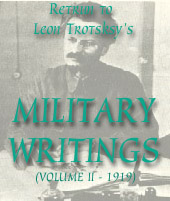
The Baltic fleet, which was restored by the joint efforts of our best naval workers, has suffered a grave blow. Three destroyers have been lost, having collided with mines during a bold nocturnal enterprise [81] Many fine lives have been lost. Despite the sorrow which pierced our hearts when we first heard the news of this blow, every one of us can cry, with legitimate pride: the spirit of the Red Navy lives!
The enterprise in which the destroyers were engaged involved exceptional risk. All the sailors who set out in the destroyers knew clearly how great the danger was. And, nevertheless, they went cheerfully and confidently into battle as though to a festival: The spirit of the Baltic fleet lives!
Danger is our inevitable fellow-traveller in the harshness of war. So long as there is war, so long there will be danger, and so long will men go forth bravely to meet it.
Men go forth bravely to meet it.
New vessels have already come up to replace those we have lost. Young, courageous fighters are taking the places of the fallen heroes. The Red Navy is alive, its spirit lives!
But the memory of the fallen will live for ever in our hearts. From the commander of the division to the most junior of the sailors, they gave us an example of valour and solidarity in struggle and in death itself. Even the White-Guard wireless was obliged to acknowledge the courage of the crew and the loyalty of the commanders to the Soviet flag.
May the memory of this blow suffered through the fate of war weld together more closely the family of Red sailors of the Baltic Sea. May its waves wipe away the last traces of dissension. May the flag of the Baltic fleet become the flag of fraternal unity and service to the freedom and independence of the working people of Russia. Glory to the fallen! Long live the Baltic Fleet, and may its spirit be steeled by its trials!
81. On October 21, when General Yudenich’s army, resisting stubbornly, was trying to protect the left flank of its retreating units, movement by the enemy vessels was observed in Koporya Bay. Considering that an enemy landing was possible, the command of the Baltic fleet ordered a night operation to lay a minefield in the bay. The four destroyers which undertook this task – Mani, Gavnil, Konstantin and Svoboda – collided with mines, and three of them were blown up and sunk. The fourth, Azard, returned safely to Kronstadt.

Last updated on: 23.12.2006